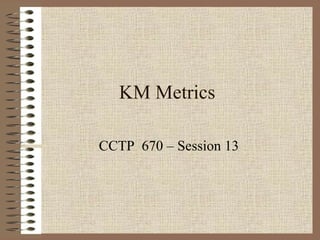KM
- 1. KM Metrics CCTP 670 – Session 13
- 2. Context for Measuring KM Knowledge management is always undertaken in a context – business goals, business strategy, knowledge strategy Measure progress in achieving KM strategy, business strategy & business goals Also measure to manage the KM implementation process, measure the value of the implementation decision & lessons learned, and to develop benchmarks There is no one ‘right’ set of metrics – combination of measurement types and classes is generally required
- 3. Metrics, Metrics Everywhere There are many measurement approaches available to assess knowledge management How do you select approaches that are suited to your context? Understand the context Select measures that are actionable
- 4. Five Steps to Defining KM Metrics Having already defined business objectives and the KM strategy Step 1 – Who are the stakeholders & what do they need to know? Step 2 – Which framework is best? Step 3 – What should you measure? Step 4 – How should you collect and analyze the measures? Step 5 – What do the measures tell us and how should we change?
- 5. Before You Start – Review Your Objectives What were you trying to achieve with a KM strategy? What were your business applications? Before you begin the KM measurement process you need to put the task in context – in order to get the measurement process right Dept. of Navy identifies three types of business objectives that can benefit from KM strategies Program & process management? Program execution & operations? Personnel and training?
- 6. Program & Process Management Focus on strategic organizational objectives such as leveraging best practices and transferring lessons learned Help to solve issues such as achieving consistency across the organization and preventing duplication of effor
- 7. Program Execution & Operations Focus on connecting people with experts, transferring expertise, getting the right operational knowledge to people in the field when they need it
- 8. Personnel & Training (Learning) Personnel & learning issues such as acquiring and retaining intellectual assets and improving the quality of life for employees
- 10. Step 1 - Stakeholders Tailor your measures to meet the stakeholders needs Stakeholders – who will use the measures you select? What are the most important questions the stakeholders have? What are the most important decisions the stakeholders will make – how will they use the measures/information you give them?
- 11. Step 2 - Framework Define a measurement framework consistent with the business objectives Should be suited to your overall performance measurement framework Different ways to construct a framework – best is the one that makes it easiest to understand the relationship of your KM processes to your business goals
- 12. Framework Examples Flow framework – traces KM activities to impacts – illustrates KM benefits Matrix measure shows the rationale for prioritizing among a group of KM projects – illustrates relationship between several factors Causal loop diagrams illustrate relationships between key parts of a ‘system’ Balanced scorecard provides a view of business performance by combining customer perspective, internal perspective, innovation/learning perspective, financial perspective
- 13. Balanced Scorecard Example Aligns measures with strategies in order to track progress, reinforce accountability and prioritize improvement opportunities Integrates: Customer perspective – how customers see you Internal perspective – what should you excel at? Innovation & learning perspective – continuous improvement & value creation Financial perspective – how look to stakeholders
- 15. Measuring from Different Perspectives Outcome measures enterprise level value Impact of KM on the organization Output measures project or task level value Measure process output for users System measures relate performance of IT to KM Indirect indication of knowledge sharing & reuse
- 16. Step 3 – What to Measure? Does the metric tell you whether knowledge is being shared and used? Metrics should be tied to the maturity of the KM process – may need to change in each stage of the KM life cycle Quantitative measures – evaluate performance over time, show trends Qualitative measures - provide context & meaning for quantitative measures, & helps to describe intangible benefits
- 17. Measuring Intangible Assets Typical metrics can account for asset use by depletion Intellectual assets, though, grow when they are used Four examples of metrics for intangible assets: Intangible Asset Monitor (Sveiby) Skandia Navigator Intellectual Capital Index Storytelling
- 18. Intangible Assets Monitor People are only true agents in business All assets result from the actions of people Focuses on – individual competence, internal structure, external structure
- 19. Skandia Navigator Combines Intangible Assets Monitor with Balanced Scroecard approach Defines two components of intellectual capital Human Capital Structural Capital
- 20. Intellectual Capital Index Flows & stocks of intellectual capital Roos index measures Human capital (competence, attitude, intellectual agility, knowledge capital, skill capital) Structural capital (external relationships, internal organization, renewal and development, strategic processes, flow of products and services)
- 21. Storytelling Used in conjunction with other measurement approaches Stories capture context which gives them meaning People make sense out of things by telling stories
- 22. Step 4 – How to Collect & Analyze Data? Before you implement your KM program, you should have an idea of what you will need to measure & how you will collect data for the measures Data collection methods typically used in organizational management are suitable for KM data collection For example, surveys, interviews, workshops, focus groups, organizational records & strategies,
- 23. Step 5 – Learning How to Change Dynamic nature of a KM process means that you should always be open to learning: What should be changed How to change it When to introduce the changes






















